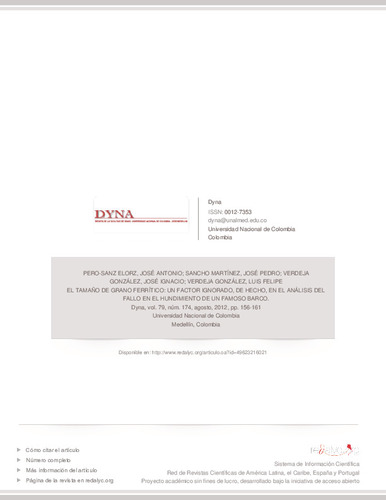El tamaño de grano ferrítico: un factor ignorado, de hecho, en el análisis del fallo en el hundimiento de un famoso barco
Otros títulos:
Ferritic grain size: an ignored factor, in fact, in the failure analysis of the sinking of a famous ship
Palabra(s) clave:
Titanic
Ferritic structure
Fecha de publicación:
Editorial:
Universidad Nacional de Colombia
Citación:
Descripción física:
Resumen:
In much of the literature published on the sinking of the famous ocean liner Titanic, on April 15, 1912 in the North Atlantic after hitting an iceberg, it has not been done a sufficiently rigorous analysis on the causes of it, in relation to the material behavior, given the vessel maneuver and the shock produced. The riveted steel plates, hull material, opened a huge crack of several tens of meters and there is no satisfactory explanation enough today. The steel was qualified poor for excess sulfur, giving excessive importance to the presence of manganese sulphide inclusions not globular shape, giving too much atention on the failure of the rivets. Actually the primordial cause was, in our opinion, the absence of grain refining alloyings and appropiate heat treatment of the plate, which produced excessive grain size. Under the conditions of navigation in waters below 0 ° C, the steel of the Titanic had amply exceeded the ductile-fragile transition temperature, turning the boat hull into a “crystal” container
In much of the literature published on the sinking of the famous ocean liner Titanic, on April 15, 1912 in the North Atlantic after hitting an iceberg, it has not been done a sufficiently rigorous analysis on the causes of it, in relation to the material behavior, given the vessel maneuver and the shock produced. The riveted steel plates, hull material, opened a huge crack of several tens of meters and there is no satisfactory explanation enough today. The steel was qualified poor for excess sulfur, giving excessive importance to the presence of manganese sulphide inclusions not globular shape, giving too much atention on the failure of the rivets. Actually the primordial cause was, in our opinion, the absence of grain refining alloyings and appropiate heat treatment of the plate, which produced excessive grain size. Under the conditions of navigation in waters below 0 ° C, the steel of the Titanic had amply exceeded the ductile-fragile transition temperature, turning the boat hull into a “crystal” container
Colecciones
- Artículos [37540]
- Ciencias de los Materiales e Ingeniería Metalúrgica [155]
Ficheros en el ítem





